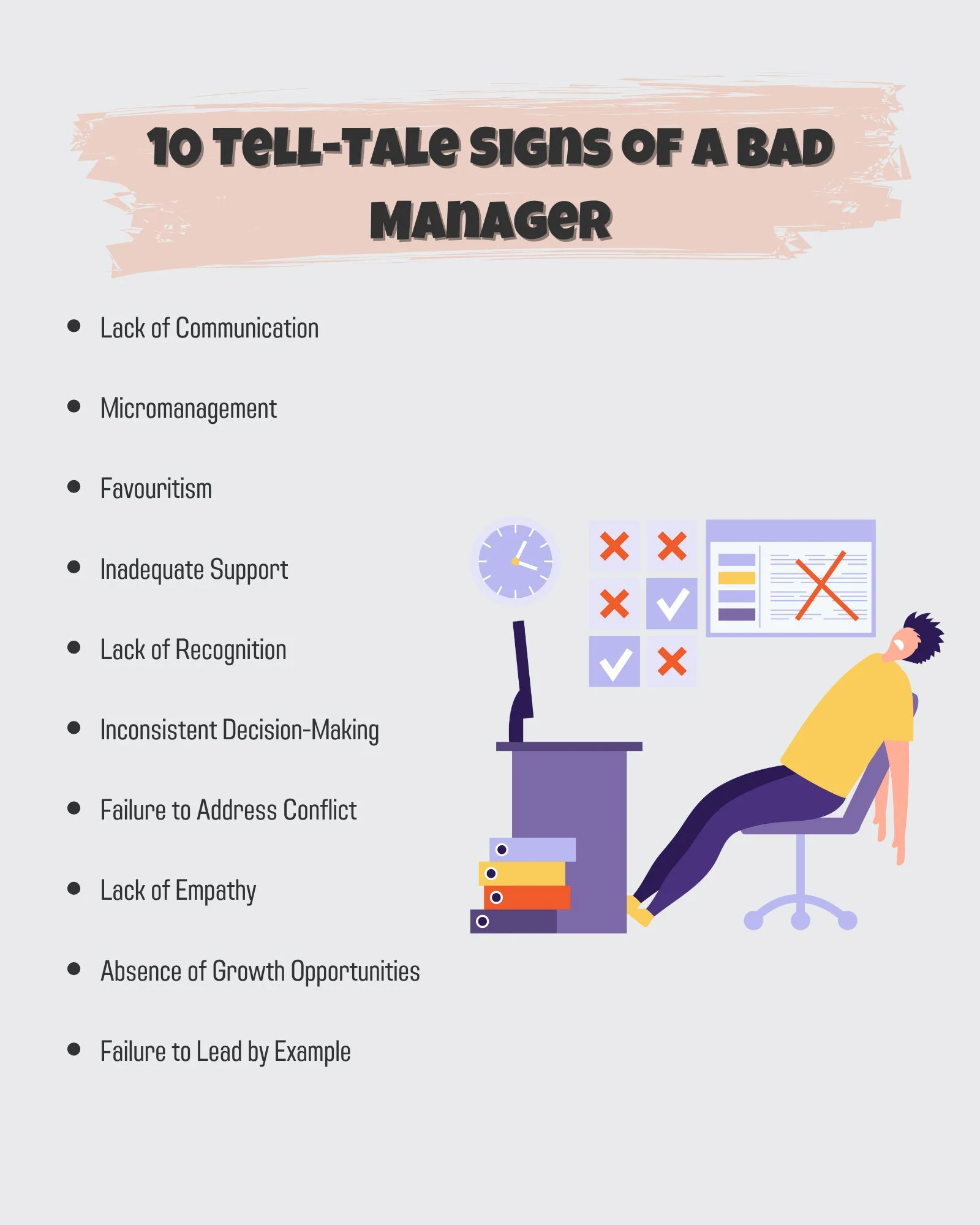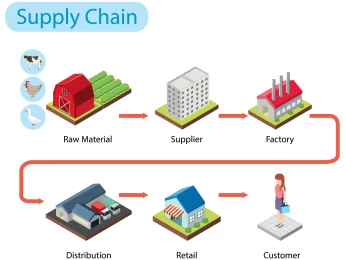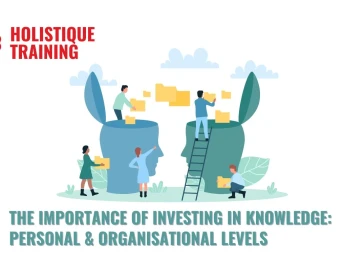- Table of Contents
- Introduction
- What Constitutes Poor Management?
- 10 Tell-Tale Signs of a Bad Manager
- Lack of Communication
- Micromanagement
- Favouritism
- Inadequate Support
- Lack of Recognition
- Inconsistent Decision-Making
- Failure to Address Conflict
- Lack of Empathy
- Absence of Growth Opportunities
- Failure to Lead by Example
- How Bad Management Affects Company Culture
- Decreased Morale
- High Turnover Rates
- Lack of Trust and Collaboration
- Reduced Employee Engagement
- Damaged Reputation
- How to Fix Poor Management Practices
- Provide Leadership Training
- Foster Open and Transparent Communication
- Implement Performance Feedback Mechanisms
- Promote Employee Empowerment
- Lead by Example
- Address Conflict Proactively
- Foster a Culture of Learning
- Exploring the Role of Technology in Improving Management
- Employee Feedback Software
- Project Management Apps
- Data Analytics
- Performance Management Systems
- Communication Platforms
- Artificial Intelligence (AI)
- Training and Development Platforms
- Employee Engagement Platforms
- Time and Attendance Software
- Cloud-Based Management Solutions
- Conclusion
Introduction
Effective management is the cornerstone of any successful organisation. Skilled managers inspire their teams, create positive work environments, and drive productivity. However, not all managers possess these qualities. Poor management can harm employee morale, productivity, and the overall success of a company. In this comprehensive blog post, we will explore the practices of a bad manager, the signs to watch out for, and the profound impact it has on a company's culture. Additionally, we will delve into actionable steps to remedy these poor management practices, promoting a healthier and more productive work environment.
What Constitutes Poor Management?
Poor management encompasses a spectrum of practices that hinder employee development, motivation, and job satisfaction. It includes a lack of effective communication, inadequate support, micromanagement, favouritism, and a failure to recognise and appreciate employee contributions. Let's delve deeper into these aspects and explore how they manifest in the workplace.
Aspect | Good Management Practices | Poor Management Practices |
Communication | Clear expectations, feedback, and guidance | Lack of clear communication, leading to confusion |
Support | Providing necessary resources, training, and mentorship | Neglecting essential support, hindering growth |
Recognition | Acknowledging and appreciating employee efforts | Neglecting to recognise contributions |
Decision-Making | Consistent decision-making patterns | Inconsistent decisions causing confusion |
Conflict Resolution | Addressing conflicts constructively | Avoiding conflicts, leading to tension |
Empathy | Supporting team members' emotional well-being | Lack of compassion and understanding |
Growth Opportunities | Identifying and nurturing employee potential | Stagnation due to lack of opportunities |
Leading by Example | Setting a positive example | Exhibiting unprofessional behaviour |
Table 1: Comparison of Good Management vs. Poor Management Practices
10 Tell-Tale Signs of a Bad Manager
According to Niagara Institute, bad management is one of the main stressors for employees. This goes to show how prevalent this issue has become. Here are some of the tell-tale signs you might have a bad manager at work, or you’re lacking of good management skills yourself:

Lack of Communication
Effective communication is the cornerstone of good management. A competent manager communicates clearly, sets expectations, provides feedback, and listens to their team. In contrast, a bad manager often leaves employees in the dark, failing to articulate goals and expectations. They may provide vague or no feedback, leaving employees feeling adrift. This lack of communication leads to confusion, decreased productivity, and frustration among team members.
Organisations can encourage managers to undergo communication training to address this issue. These programmes can teach managers how to convey expectations effectively, provide constructive feedback, and establish open lines of communication. Regular team meetings and one-on-one check-ins can also facilitate better communication within teams.
Micromanagement
Micromanagement is a detrimental management behaviour that involves excessively overseeing every aspect of an employee's work. Bad managers tend to hover over their team members, constantly checking in on progress, and making decisions for them. This stifles creativity, hampers autonomy, and undermines trust. Employees feel disempowered and may lose confidence in their abilities.
To combat micromanagement, managers should focus on delegation and trust-building. They can learn to set clear expectations, provide guidelines, and then allow employees to execute their tasks independently. Encouraging open communication and offering support when needed can help strike a balance between oversight and autonomy.
Favouritism
Favouritism is a toxic practice that can poison a work environment. When a manager plays favourites, they treat certain employees preferentially while neglecting others. This can manifest as granting plum assignments, promotions, or other advantages based on personal preferences rather than merit. As a result, those not in the manager's favour often feel undervalued, demotivated, and disengaged.
Organisations can combat favouritism by implementing fair and transparent assignments, promotions, and recognition processes. Managers should be encouraged to assess employees objectively, focusing on their skills and contributions rather than personal bias. Regular performance evaluations, conducted fairly and consistently, can help ensure that all employees have equal opportunities for growth and advancement.
Inadequate Support
Effective managers understand that their role includes providing the necessary resources, training, and mentorship for their team's success. However, bad managers may lack the essential skills required for effective team-building. Research shows that approximately 30% of employees believe their manager lacks these skills, hindering employee growth and productivity.
Organisations can address this issue by investing in leadership development programmes. These programmes should equip managers with the skills to effectively support their teams. Training in areas like mentorship, resource allocation, and professional development can help managers provide the support their teams require.
Lack of Recognition
Recognition is a fundamental driver of employee motivation. A poor manager often neglects to acknowledge and appreciate their team's efforts and achievements, leaving employees feeling undervalued and demoralised.
To address this problem, organisations should encourage a culture of recognition. Managers should be trained to provide regular and meaningful feedback, highlighting the contributions of their team members. Implementing formal recognition programmes, such as "Employee of the Month" awards or peer recognition systems, can also boost morale and motivation.
Inconsistent Decision-Making
Consistency in decision-making is essential for building trust within a team. A manager with inconsistent decision-making patterns erodes trust and creates an unpredictable work environment. Employees struggle to understand the reasoning behind decisions, resulting in confusion and decreased confidence in their leader.
Organisations can establish clear decision-making processes and guidelines to promote consistent decision-making. Managers should communicate these processes to their teams, ensuring that everyone understands how decisions are made. Additionally, transparent communication about the rationale behind decisions can help build trust and confidence among team members.
Failure to Address Conflict
Conflicts are inevitable in any workplace, but a bad manager often avoids addressing them. This allows conflicts to fester and disrupt team dynamics. Unresolved conflicts exacerbate tension and negatively impact employee morale.
Organisations can provide conflict resolution training to managers to address conflicts proactively. This training equips them with the skills to address conflicts promptly and constructively. Encouraging open dialogue, mediation, and the use of conflict resolution techniques can prevent conflicts from damaging team dynamics and morale.
Lack of Empathy
Empathy is a powerful leadership trait that enables managers to understand and support their team members' emotional well-being. A manager who lacks empathy fails to connect with their team personally, which can lead to a disengaged workforce.
Organisations can promote empathy by emphasising its importance in leadership. Leadership development programmes can include emotional intelligence and empathy modules, helping managers develop these crucial skills. Encouraging open and empathetic communication within teams can also foster a more compassionate work environment.
Absence of Growth Opportunities
A bad manager often fails to identify and nurture employee potential. This absence of growth opportunities can lead to stagnation, disengagement, and ultimately, talented employees seeking opportunities elsewhere.
To address this issue, organisations should encourage managers to actively assess and develop their team members' skills and potential. Regular performance reviews should include discussions about career goals and development plans. Providing opportunities for training, mentorship, and cross-functional projects can also promote employee growth and motivation.
Failure to Lead by Example
Effective leadership entails setting a positive example for others to follow. A bad manager, however, exhibits unprofessional behaviour, such as tardiness, lack of accountability, or disrespect, which undermines their credibility and team cohesion.
Organisations can emphasise the importance of leading by example in leadership training. Managers should be encouraged to model the behaviours they expect from their team members, demonstrating professionalism, accountability, and respect. This sets the tone for a positive work culture and fosters team cohesion.
By recognising and addressing these tell-tale signs of a bad manager, organisations can take proactive steps to improve management practices and create a healthier and more productive work environment for their employees. Effective management benefits individual employees and contributes to the organisation's overall success.
How Bad Management Affects Company Culture
Its managers' actions and behaviours significantly influence a company's culture. Poor management practices can gradually erode a healthy and positive work culture, leading to a host of detrimental effects:
Decreased Morale
A significant consequence of bad management is a decrease in employee morale. Morale refers to the overall mood, satisfaction, and motivation of employees within an organisation. Bad managers can create a toxic work environment that fosters negativity, favouritism, and inadequate support. Here's how this impacts morale:
- Negative Atmosphere: When a manager fails to address conflicts, exhibits inconsistent decision-making, or plays favourites, it creates an atmosphere of tension and distrust. Employees become wary of their colleagues and feel unsupported by their leader.
- Low Motivation: In such an environment, employees lose motivation to perform at their best. When they believe their efforts go unrecognised or are overshadowed by favouritism, they may question why they should put in extra effort.
- Increased Absenteeism: Low morale can result in more frequent absenteeism. A hostile work environment may drain employees mentally and emotionally, leading to higher rates of sick days and decreased productivity.
- Negative Feedback Loop: Low morale can quickly spiral into a negative feedback loop. As employees become demotivated, their work quality may decline, leading to even more negative feedback from management, further worsening morale.
High Turnover Rates
A high turnover rate is one of the most noticeable effects of bad management on company culture. Employees subjected to poor management practices often seek better opportunities elsewhere. Here's how bad management contributes to high turnover:
- Dissatisfaction: Employees who experience favouritism, inadequate support, or a lack of recognition often become dissatisfied with their work environment. They may feel undervalued and unappreciated.
- Search for Better Opportunities: Dissatisfied employees actively seek better job prospects where they believe their contributions will be recognised and rewarded. High employee turnover leads to disruptions in team dynamics and increased recruiting costs.
- Impact on Team Cohesion: Frequent departures due to bad management practices disrupt team cohesion and create uncertainty. New team members may struggle to integrate, while those who remain may feel overburdened by losing colleagues.
- Financial Consequences: High turnover rates are costly for organisations. The recruitment and onboarding process can be expensive and time-consuming, impacting the company's bottom line.
Lack of Trust and Collaboration
Trust is a critical foundation for any successful team. However, bad management practices can erode trust within an organisation in several ways:
- Micromanagement: Micromanaging employees signals a lack of trust in their abilities. It conveys the message that the manager believes employees are incapable of doing their jobs without constant supervision.
- Favouritism: Playing favourites breeds distrust among team members. Those who perceive that others receive preferential treatment may become sceptical of their colleagues and the manager's fairness.
- Conflict Avoidance: When a manager avoids addressing conflicts, it can lead to the perception that concerns are being swept under the rug. This lack of resolution can damage trust within the team.
- Isolation: Employees who feel unsupported and unrecognised may become isolated and less likely to collaborate with their colleagues. They may see their colleagues as competitors for limited recognition and resources.
- Innovation Hindrance: Trust is essential for fostering a culture of innovation and risk-taking. A lack of trust can stifle creativity and discourage employees from sharing new ideas or taking calculated risks.
Reduced Employee Engagement
Employee engagement refers to the extent to which employees are emotionally invested in their work and committed to their organisation's goals. Bad management practices can significantly reduce employee engagement:
- Lack of Recognition: Employees may become disengaged when their efforts go unnoticed or unappreciated. Recognition is a powerful motivator, and its absence can lead to feelings of apathy and disinterest.
- Inadequate Support: Employees who do not receive the necessary support, resources, or opportunities for growth may become disengaged and feel that their career development is stagnant.
- Negative Atmosphere: A workplace marked by tension, conflict, and favouritism is not conducive to employee engagement. Employees may disengage to protect themselves emotionally from the negative environment.
- Impact on Productivity: Disengaged employees are less productive and innovative. They may do the minimum required to get by, decreasing overall productivity.
Damaged Reputation
A company's reputation plays a significant role in attracting and retaining top talent. Bad management practices can harm a company's reputation in several ways:
- Word of Mouth: Employees who have experienced poor management practices are likely to share their negative experiences with others. Word of mouth can quickly spread, damaging the company's reputation.
- Online Reviews: In the digital age, employees can share their experiences on websites like Glassdoor, LinkedIn, and other social media platforms. Negative reviews can deter prospective talent.
- Recruitment Challenges: A company known for its poor management practices may struggle to attract top-tier candidates. Talented individuals often seek out organisations with a positive work culture and effective management.
- Impact on Customers and Clients: An unhealthy company culture can indirectly affect customer and client relationships. Employees who are disengaged or unhappy may provide subpar customer service or fail to meet client expectations.
In summary, bad management practices can profoundly and negatively impact a company's culture. They lead to decreased morale, high turnover rates, a lack of trust and collaboration, reduced employee engagement, and damage to the company's reputation. Addressing these issues through improved management practices and a commitment to fostering a healthy work culture is crucial for the long-term success of any organisation.
How to Fix Poor Management Practices
Addressing poor management practices is crucial for fostering a healthier work environment and improving company culture. Here are actionable steps to rectify these issues:
Provide Leadership Training
Investing in leadership development programmes is essential to equip managers with the necessary skills to lead effectively. These programmes should not be one-time events but rather ongoing initiatives that promote continuous growth and improvement in leadership capabilities. Training modules should cover areas such as communication, emotional intelligence, conflict resolution, and fostering a positive work culture. Leadership training is an investment in the long-term success of both managers and the organisation as a whole.
Foster Open and Transparent Communication
Encouraging open and transparent communication is vital for building trust and creating a positive work environment. Organisations should provide managers with tools and resources to communicate clearly and regularly with their team members. Establishing channels for feedback, such as regular team meetings and anonymous suggestion boxes, ensures that communication flows both ways. By fostering a culture of transparency, organisations can enhance employee engagement and collaboration.
Implement Performance Feedback Mechanisms
Establishing robust performance feedback mechanisms is crucial for recognising and addressing poor management practices. Organisations should implement formal performance management systems that encourage regular feedback and recognition. Managers should be trained to provide constructive feedback that helps employees grow and improve. Additionally, recognising and appreciating employee contributions should be integrated into the organisation's culture. This consistent feedback loop motivates employees and aligns their efforts with the organisation's goals.
Promote Employee Empowerment
Promoting employee empowerment is key to building a culture of ownership and responsibility. Managers should be encouraged to delegate tasks, grant autonomy, and empower their team members to make decisions within their areas of responsibility. This enhances employee job satisfaction and fosters innovation and creativity within the organisation. Empowered employees are likelier to take ownership of their work and contribute to the organisation's success.
Lead by Example
Leading by example is a fundamental principle of effective management. Managers should exhibit professionalism, accountability, and empathy in their daily interactions. They should model the behaviours they expect from their team members, demonstrating a strong work ethic and a commitment to the organisation's values. Leading by example sets the tone for a positive work culture and inspires team members to emulate these qualities. It reinforces the importance of ethical conduct and accountability throughout the organisation.
Address Conflict Proactively
Addressing conflicts proactively is essential for maintaining a healthy work environment. Organisations should provide managers with conflict resolution training to equip them with the skills to address conflicts promptly and constructively. Encouraging open dialogue and mediation can prevent unresolved conflicts from damaging team dynamics and morale. Organisations can create a more collaborative and harmonious workplace by fostering a culture where conflicts are seen as opportunities for growth and improvement.
Foster a Culture of Learning
Creating a culture of learning is essential for employee development and growth. Organisations should invest in professional development opportunities like training programmes, mentorship, and cross-functional projects. Managers can foster engagement, loyalty, and a motivated workforce by providing employees with opportunities to acquire new skills and knowledge. Furthermore, learning should not be a one-way street; organisations should encourage managers to seek feedback from their team members and continually refine their leadership skills. So, if you’re looking to do that, make sure to check out our course ‘Perfecting Your Management and Leadership Skills’.
Incorporating these strategies into the organisation's management practices can transform leadership effectiveness, ultimately driving employee engagement, retention, and overall success. These actions demonstrate a commitment to fostering a positive work culture where employees thrive and the organisation as a whole benefits from improved management practices.
Exploring the Role of Technology in Improving Management
Modern technology is pivotal in helping managers become more effective in various aspects of their roles. Here, we will delve deep into the multifaceted role of technology in improving management practices:
Employee Feedback Software
Technology has enabled the development of sophisticated employee feedback software that facilitates ongoing communication between managers and team members. These tools allow employees to share their thoughts, concerns, and suggestions anonymously, fostering open and honest dialogue. Managers can gain valuable insights into employee sentiments, identify issues early, and proactively address them.
Project Management Apps
Project management applications streamline the planning, execution, and monitoring of tasks and projects. These tools enable managers to allocate resources efficiently, set clear deadlines, and track progress in real-time. By providing a centralised hub for collaboration and task management, project management apps enhance productivity and transparency within teams.
Data Analytics
Advanced data analytics tools allow managers to make data-driven decisions. These tools can process vast amounts of data to identify trends, patterns, and performance metrics. Managers can use data analytics to assess employee productivity, identify areas for improvement, and optimise resource allocation. This data-driven approach helps managers make informed decisions that benefit the organisation.
Performance Management Systems
Technology-driven performance management systems provide a structured framework for setting goals, tracking progress, and conducting performance evaluations. These systems can automate the performance review process, making it more efficient and objective. Managers can use these systems to provide timely feedback, set development goals, and align individual performance with organisational objectives.
Communication Platforms
Communication platforms such as Slack, Microsoft Teams, and Zoom facilitate seamless communication and collaboration among remote and distributed teams. These tools enable managers to conduct virtual meetings, share documents, and maintain open lines of communication with team members regardless of their location. Effective communication platforms enhance team connectivity and productivity.
Aspect of Management | Remote Work | In-Office Work |
Communication | Relies on digital toolss and apps | Face-to-face interactions |
Supervision | Emphasises results and autonomy | Direct oversight and presence |
Team Collaboration | Virtual meetings and shared docs | In-person meetings & teamwork |
Performance Tracking | Data-driven, remote monitoring | Observation and direct feedback |
Work-life Balance | Flexible schedules, remote perks | Structured office hours |
Employee Engagment | Relies on Virtual engagment | Persnall connections at work |
Productivity | Foocus on outcomes & self-motivation | Office environment influence |
Table 2: Management practices in remote vs. in-office work
Artificial Intelligence (AI)
AI-powered tools offer innovative solutions for management tasks. Chatbots, for instance, can assist managers in answering routine questions and handling administrative tasks, allowing them to focus on more strategic responsibilities. AI can also analyse large datasets to uncover insights and predict future trends, aiding in decision-making.
Training and Development Platforms
Online learning management systems (LMS) make it easier for managers to access training and development resources. These platforms offer various courses, webinars, and resources on leadership, communication, and management skills. Through online training, managers can enhance their capabilities and stay up-to-date with industry best practices.
Employee Engagement Platforms
Technology-driven employee engagement platforms provide managers with tools to measure and improve employee engagement. These platforms typically include surveys, pulse checks, and analytics that help managers identify areas where employee engagement may be lacking. This data allows managers to implement targeted strategies to boost engagement and morale.
Time and Attendance Software
Managing time and attendance can be challenging, especially in larger organisations. Time and attendance software automates tracking employee work hours, vacation requests, and attendance records. Managers can easily monitor attendance, enforce policies, and generate reports, saving time and ensuring compliance with labour regulations.
Cloud-Based Management Solutions
Cloud-based management solutions offer managers flexibility and accessibility. Managers can access essential management tools and data from anywhere with an internet connection. This flexibility is particularly valuable for remote or mobile managers who must stay connected and manage teams across different locations.
Incorporating these technological tools and solutions into management practices can lead to more efficient, data-driven, and responsive leadership. Managers can leverage technology to enhance communication, streamline processes, make informed decisions, and ultimately create a more productive and engaged workforce.
Conclusion
In conclusion, poor management practices can have far-reaching consequences for an organisation. Companies can create a healthier and more productive work environment by recognising the signs of bad management and taking proactive steps to address them. Investing in leadership development, fostering open communication, promoting employee empowerment, and addressing conflicts are essential to building a positive work culture. By implementing these practices, organisations can transform their managers into effective leaders, driving employee engagement, retention, and overall success.
























